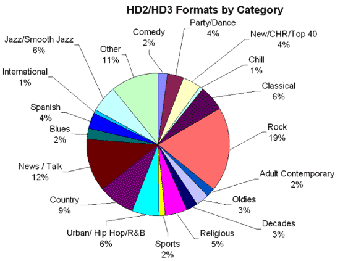Dissertation research, phase two: explore and catalog interesting information about HD Radio from all available electronic resources except the FCC’s actual, entire rulemaking (that’s phase three). Initially, this involved exploring HD Radio’s proponents and how they present themselves online. It’s quite an extensive presence, involving two corporate portals, one consumer-marketing site, and a (user-restricted) site involving broadcaster and retailer education.
I just finished scouring the consumer-portal, where I re-stumbled upon a news release from March in which the HD Radio Alliance touted 1,000 FM stations now multicasting, and 100 receiver-models in production. The release includes two graphs.
The first one involves multicast broadcast-penetration, which is nothing to write home about. A relatively constant growth-line, extending from the first multicast going on the air around mid-July 2005 and hitting the 1,000 mark in March of 2009.
Note that seven years ago, when the FCC first conditionally approved the adoption of HD Radio, multicasting wasn’t even in the feature-set. Crash-developed by NPR starting in 2003, which formally released it to the broadcast community (via iBiquity, following the FCC’s nod) in 2006, it’s no surprise the graph-line stays at zero in the beginning: the technology simply wasn’t there yet.
 It’s the second graph, however, which caught my eye.
It’s the second graph, however, which caught my eye.
Just a cursory glance around the pie-chart (click for larger image) belies the claim that HD Radio increases program diversity: the only “new” formats I recognize are “Comedy” (2%), “Chill” (1%), “International” (1%), and “Other” (11%).
Through a jaundiced eye, that adds up to 15% of all HD multicast (i.e., digital-only) channels actually adding something substantive to the listener’s aural palate.
According to the Alliance, “There are 1,923 stations in the US broadcasting 2,993 HD Radio channels, 204 more coming soon.”
Working with the aggregate HD station total (2,127) and subtracting that from the number of existing “HD Radio channels” (2,993) leaves us with a figure of 866 multicast channels – a dubious conclusion, given the claim that more than 1,000 were on the air five months ago.
From there, we can derive that 15% – or a whopping 130 multicast channels – exist right now that might actually offer up something new to a listener lucky enough to be in that innovative market (and equipped with the proper receiver, which in itself is an interesting story), as opposed to a derivation on the same-old.
I snagged the HD Radio Alliance’s complete station-guide and will run a more thorough analysis on the issue of format diversity, with special interest in actual geographic penetration (where is multicasting most prevalent) and for correlations in station ownership (who is most active in the multicasting sphere).
Skip to content